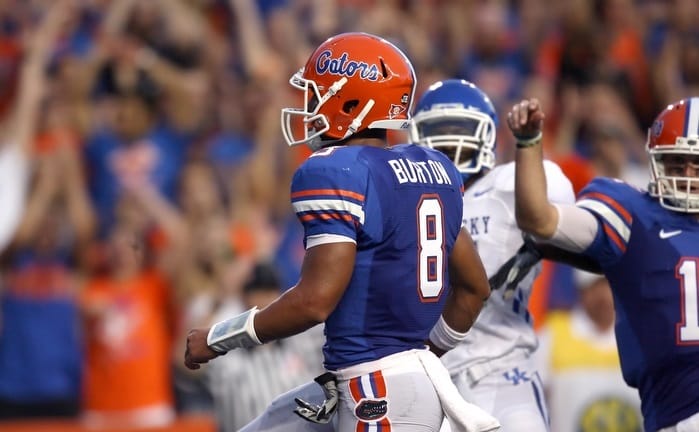Trey Burton and his role in the offense is arguably one of the most debated topics in Florida Gator football discussion groups. Two opposing sides debate his effectiveness by pointing to statistics to prove their point – one side points to games against Kentucky (2010) and Tennessee (2012) where Burton had high yardage games; and the other side points to ineffectiveness in the other 35 games against the Football Bowl Subdivision (FBS) teams.
For the first time, Burton’s production in total yards (rushing, receiving, passing) were compared to the quality of defense the Gators faced, which was determined by the rank of each team’s national total defense ranking for that season.
(While this graph is by no means a complex statistical analysis, it is a comparison of yards versus rankings to look at correlation, and perhaps, causation.)
A quick run-through of the graph shows a few things. Trey Burton’s highest yardage output was 136 total yards, which he amassed versus Georgia in 2010, a team that finished the season ranked 23rd in total defense. Burton’s lowest output was -12 yards in a game against Florida State in 2011, a team that finished 4th in the country in total defense that year. Across the board, a linear trend-line shows that Burton’s average yards per game have fallen from about 26 yards per game to about 17 from 2010 to 2013 (albeit only two games in the 2013 season).
Now let’s get into some analysis. As previously mentioned, Burton’s best statistical yardage game was against Georgia with a 113-point positive difference between total yards and rank of defense. His second best game, in yardage against the defensive ranking, was his big game against Kentucky (2010) where there was a 38-point positive difference (yards over defensive ranking). Other games that Burton had more yards versus defenses: LSU (2010) +23, Alabama (2011) +2, LSU (2011) +11, South Carolina (2011) +2, Ohio State (2011) +4, Florida State (2012) +25, and Miami (2013) +20.
Ergo, numbers show, that in nine games in his career Burton has performed “better” than the quality of defense that he played against. Now that number is varied and not a perfect science, because in one game (Alabama 2011) Burton had 3 total yards, but it was against the number one defense in the country, therefore his performance yielded a positive number.
On the other side, Burton has 28 games that he has totaled fewer yards than the rank of the defense nationally. His largest disparity was against Louisiana-Lafayette (2012), where he only had three yards against the 87th ranked defense. Burton also had large disparities to start the 2011 season with a zero yard performance against Florida Atlantic and a 46 yard performance against Alabama-Birmingham, a 69 and 68 point difference, respectively.
Let’s look deeper into the blue line and the red line and noticeable similarities. Burton has accrued more than 30 yards against the 44th, 12th, 23rd, 93rd, 46th, 42nd, 114th, 58th, 110th, 71st and 40th defenses. Burton has accrued 10 or less yards against the 28th, 17th, 69th, 5th, 27th, 1st, 2nd, 5th, 3rd, 4th, 6th, 58th, 8th, 19th, 32nd, 59th, and 87th defense. These numbers show that Burton averages more than 30 yards when the defense is significantly worse (59.36) than when he accrues 10 or less (25.29), which of course means that Florida had a higher propensity to achieve less yards, but the numbers are staggering. For example, every game the Florida Gators have faced a top-10 defense since 2010, Trey Burton has only averaged 4.88 yards per game.
Now, I know that offensive production is not based totally on yards and the number of times a player touches the ball changes each game, so it is certainly not a perfect science. However, the numbers do not lie. You see spikes in the blue line (total yards) when you see spikes in the red line (national rank of defense) and that line shows the correlation that Burton’s biggest offensive output have been against the weakest defensive competition.
None of this is to say that Burton does not have a role in the Florida offense, but it does provide context to production.



Without the analysis one thing is obvious. Of late, when Trey Burton goes into the wildcat other teams know what to expect and they usually smother it. If he cannot throw the ball, or will not hand off on an option, then the Wildcat is a detriment.
Well, there is a second obvious point. Trey Burton is not likely to reverse his field in the Gator backfield and turn a poor play into a positive one. He is more likely to turn a poor play into a really bad one–especially if it is in the red zone.
Coaches. Are you listening?